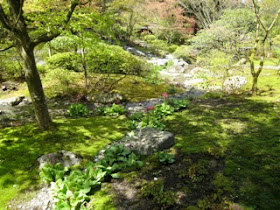by aleks
• Reminder about upcoming Guides' Cont. Ed. meeting next
Thursday, May 19 - Water from garden entrance to exit, by Kathleen Blanchard - SJG former master gardener, in Tateuchi Room
• One of our guides, Dewey Webster, is giving the
Seattle Chinese Garden tour for SJG volunteers at 1:30 on Saturday, June 4 - all volunteers welcome. The Chinese Garden is located at 6000 16th Avenue Southwest Seattle, WA 98106 -
click here for a map & directions (adjacent to South Seattle Community College). All visitors reading this please check the
SCG website for hours, admission and events - it's a new and exciting Garden in Seattle!
• The info below comes from another of our guides, Joan Laage, a professional butoh dancer.
The Next WAVE Seattle Butoh Festival, running June 3rd through the 18th 2011, includes performances, workshops and forums. International butoh masters Koichi and Hiroko Tamano, co-directors of San Francisco Bay Area based Harupin Ha, will be the featured along with New York artist Tanya Calamoneri and Los Angeles based Michael Sakamoto. Butoh founder Tatsumi Hijikata called Koichi "the bow-legged Nijinsky.” This may be the last chance to see the Tamano's work as they plan to retire later this year and return to Japan where the emperor has declared Koichi a national treasure. Each evening will include DAIPAN members as well including Seattle Japanese Garden docent Joan Laage. Information: Joan at davidthornbrugh@hotmail.com or
www.daipanbutoh.com. DAIPAN is accepting donations through
www.kickstarter.com; we are deeply appreciative of any contributions you can make.
 |
| Black Widow by Serge Gubelman: Joan Laage will be performing on June 3rd at Velocity |
PERFORMANCES:
JUNE 3rd & 4th 7:30 pm at Velocity Dance Center, 1612 12th Ave Seattle, WA 98122
•
Friday 3rd - Harupin Ha, Sheri Brown, Joan Laage, Helen Thorsen
• Saturday 4th - Tanya Calamoneri, Michael Sakamoto, Danse Perdue, Douglas Ridings
$15
www.brownpapertickets.com or $20 door; information: 206 729 2054
•
JUNE 11th “Art on the Fly” 2:15 pm at Whole Foods Market, 2210 Westlake ;
3:15 pm at Lake Union Park, 860 Terry Ave N
*Free
•
JUNE 18th 8:30 pm, Teatro de la Psychomachia, 1531 1st Ave S
FORUMS:
•
JUNE 3rd 11:00am -1:00 pm Historical Context of butoh (with films), butoh pioneer Joan Laage and panelists, Frye Art Museum, 704 Terry Ave
•
JUNE 5th 4:00-6:00 pm Zen/spirituality/philosophy of butoh with butoh & Zen scholars at Seattle University, 901 12th Ave. Please use the Broadway entrance to the college and follow the signs to the Wyckoff Auditorium- Engineering Department Room #200.
•
JUNE 9th 7:00-9:00pm Contemporary Cross Currents, Katsura Kan, Tanya Lockyer and DAIPAN community discuss butoh’s interface/influence with the contemporary dance aesthetic at Cornish College for the Arts, Raisbeck Hall, 2015 Boren Ave.
DAIPAN Workshops: June 4th -7th
• JUNE 4th – 5th KOICHI & HIROKO TAMANO (SF)
This is a unique opportunity to study with artists who embody the techniques and spirit of Hijikata, having studied and performed under him for over 10 years. Through the workshop, participants will learn a variety of practices that explore an intensified, embodied presence using nature imagery, the imagination, and rigorous physicality.
• JUNE 6th TANYA CALAMONERI (NYC)
• JUNE 7th MICHAEL SAKAMOTO (LA)
Check
www.daipanbutoh.com for times, prices, workshop descriptions and artist bios.
DAIPANbutoh Collective welcomes you to support our exciting current project The Next WAVE Seattle Butoh Festival 2011. DAIPAN is a community of performers linked by butoh philosophy and aesthetics. Originating in Japan in the aftermath of WWII, butoh energetically questions the nature of country, history, and personal identity, and tries to envision the creation of a future springing from the devastation. We formed our collective to support local and international performers and to provide outreach and education through workshops, classes and symposiums.
Here are several ways to support our festival:
Donations - See
Kickstarter.com and look for “Next WAVE Seattle Butoh Festival 2011.” Through Kickstarter and our partnership with Shunpike, donations are tax deductible.
Buying an AD - buying ad space in our programs; contact Helen Thorsen at 206.723.2315.
















